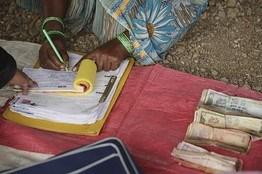
Financial service business, Shriram Group, has received a $15 million investment from LeapFrog Investment, a $135 million social investment financial services fund, that is backed by George Soros, Pierre Omidyar, and a consortium of banks, pension funds, and reinusrers. Shriram Group focuses on financial services including insurance products for low-income groups in India. The $15 investment will help Shriram Group continue to reach consumers with an annual income of $2,500. In addition, Shriram Group will double its coverage so that clients are covered up to $11,000. There will be a monthly premium of $22.
By MEGHA BAHREE
MUMBAI — Is microinsurance the next microfinance?
Giving small loans to low-income borrowers was a booming business in India until recently, when new restrictions on lending practices in the southern state of Andhra Pradesh brought the industry to a grinding halt.
But earlier this week LeapFrog Investments, a $135-million social investment fund, unveiled a $15-million investment in a unit of Shriram Group, a Chennai-based financial services company, that is targeting the lower-end mass market — but with insurance rather than loans.
Shriram Group already offers financing, insurance and retail brokerage services to the lower- income masses across India. Now, through its unit, Shriram Capital, it plans to increase its life insurance coverage of up to $11,000, more than double the current $4,500, a vast amount for most of its target audience, for a monthly premium of up to $22.”It’s very difficult for societies to develop without the ability to transfer risk,” says Jim Roth, co-founder of LeapFrog. Insurance, he believes, is key for that.
But Mr. Roth is also clear that such a business needs to make a profit. “If we don’t make a profit, this is not going to be sustainable,” he said. “We don’t make a big margin on each client, but we look at a large number, a large base.”
He added: “And in India where only 2% of [our target audience] has insurance, the potential is huge.”
Insurance that caters to India’s masses offers a major opportunity in India, says Ashvin Parekh, a partner at Ernst & Young. “Microinsurance is a volumes game. If you generate adequate number of policy holders or investors and you can [figure out a system to] collect periodic premiums, there is money to be made.”
Microinsurance is different from microfinance which offers small loans through an organized mechanism to groups of poor people to invest in small businesses. Microinsurance, on the other hand, is like regular insurance, only in much smaller amounts and with lower premiums than standard insurance.
In the last decade, banks and financial institutions have rushed to offer insurance to wealthier urban India. Typical insurance policies are sold by salespeople who operate on a high commission basis, automatically leaving out the millions of teachers in small towns and drivers and maids in cities, who make up the lower economic class in India.
G.S. Sundararajan, managing director of Shriram Capital, says they are targeting people with an average annual income of $2,500. “The typical Indian psyche doesn’t take insurance, especially at the lower income group where they have a tough time making ends meet,” he said.
Shriram’s target audience and its environment for selling the new insurance can be found on the main street of a Mumbai suburb.
Amid stores selling bathroom fittings, ceramic tiles and fax and photocopy services, is a run-down building without an elevator. Out of a basic one-room office that provides loans and transport insurance to small entrepreneurs who run four trucks or fewer.
Satnam Singh Sandhu, a skinny man in a blue turban and with a flowing beard, is a typical Shriram client. He has one truck and earns up to $215 a month on which he has to support his mother, his sister-in-law and her three children.
A Shriram customer for three years, Mr. Sandhu, 39, so far only has insurance for his transportation business. When asked if he would be willing to pay up to $22 a month from his meager earnings for life insurance, he promptly said yes. “If something happens to me, then at least my family will have something to keep them going,” he said.
http://online.wsj.com/article/SB10001424053111903285704576557601686388640.html
